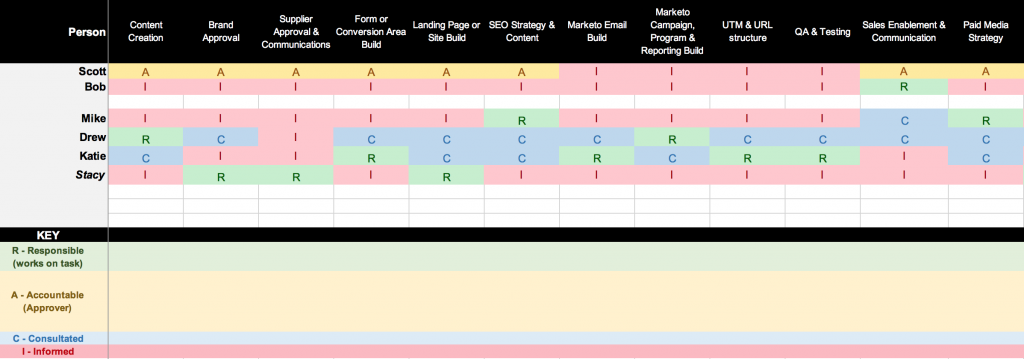The Secret to Sales-Enabled Marketing Campaigns: RACI

Marketers often struggle to effectively collaborate with sales in marketing campaigns. Despite the ego of many marketers, sales’ participation is often critical for marketing campaigns to be their most effective. From driving webinar registrations, to following up on content downloads, marketers need sellers as much as sellers need marketers. Yet, too often marketers silo the strategy, planning, and execution of their campaigns outside of sales’ purview.
There’s a better way. Research around meaningful sales and marketing alignment shows that companies grow faster when they plan their sales-enabled marketing campaigns together. How? Read on to learn about the RACI approach, which utilizes a simple project management formula to bring structure to the ever-changing needs of sales and marketing departments.
What is a RACI?
In a nutshell, a RACI chart is a responsibility assignment matrix that details how various roles will participate in completing a projects’ tasks or deliverables . We know marketers love a good acronym, so let’s dig into how this one defines the project stakeholders:
- Responsible: The person who does the work to complete the task.
- Accountable: The person who delegates the work. This person is the last to review the task or deliverable before it’s considered complete.
- Consulted: The person or parties who provide input based on how the work will impact their future project initiatives/area of expertise.
- Informed: The person or parties who need to be updated on project progress. This role does not get brought into every detail of the project.
Practical Rules for Creating a RACI
Creating your first RACI? Follow these simple rules to avoid delays and confusion among collaborators:
- Every task requires at least one responsible party, but more than one person can be responsible for the same task.
- A responsible party can also act as the accountable party.
- You can’t have more than one accountable party for each task. Since the accountable person has the final sign-off, if you’ve got more than one, decision-making becomes a blocker.
- Unable to assign just one accountable party? Consider breaking the task into more granular definitions.
- Be cognizant of how many “responsible” tasks you’ve assigned to one person. Avoid overloading.
- Every team member has a role on each task. If your team is large, you’ll have quite a few “informed” parties.
- If you have a lot of consulted and informed roles on your chart, make sure you have an easy and direct way to keep them updated.
RACI Example for Sales-Enabled Campaigning
Ready to see how this all comes together? Below you’ll find a small section of a campaign-planning RACI worksheet.

Campaign Planning RACI
In the above example, Scott is the executive marketing leader, Bob is the executive sales leader, and the rest of the folks are on the marketing project team, with Stacy as the project manager and outsourced creative lead.
Beyond Sales-Enabled Marketing Campaigns
Leveraging a RACI matrix is an invaluable tool for enabling sales collaboration. But a RACI also can be used in various other professional circumstances, such as when:
- There’s conflict about task ownership or decision-making
- You have resources that are over-allocated
- You need to speed-up approvals by streamlining communication
- You’re mitigating a single point of failure or frustration over working in silos
- A person or parties are overruling processes or decisions
In Conclusion
Executing a project doesn’t have to be an exercise in frustration. If you take the time to create roles and responsibilities upfront via a RACI chart, you’ll not only set yourself up for enhanced alignment among your marketing and sales teams, but also have a tool in your back pocket that can smooth the execution of a variety of initiatives. Ready? Set? RACI—and cheers to a better planning process.






